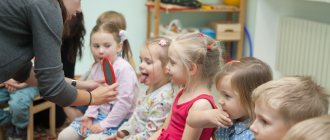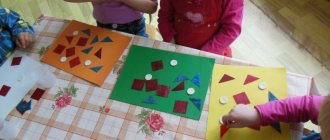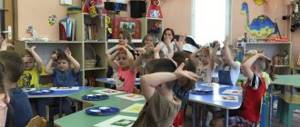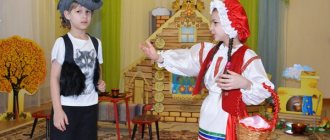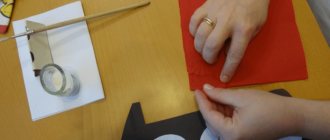Abstract of the educational activity “Journey to the winter forest”. Middle group
Direct educational activity in the middle group “Journey to the winter forest”
Objectives: - consolidate children’s knowledge about the life of animals in winter: where they live, what they eat, expand their knowledge about the habits of forest inhabitants; — establish the simplest cause-and-effect relationships about the properties of snow, draw conclusions; - develop the ability to listen to each other’s answers and reason; — enrich vocabulary (“mouses”); — continue to acquaint children with the habits and characteristics of the life of wild animals (using the “Empathy” technique - Triz); — teach children to express their point of view. — develop children’s thinking (independently identify the essential characteristics of animals, record and generalize them according to the elements of the model for use in the game); — develop in children artistry and the ability to convey text in prose; - develop curiosity, imagination, memory, horizons. - continue to develop in children an emotionally-friendly attitude towards living beings; — to cultivate a love of nature, interest in animals, and respect for one’s health. Preliminary work: Viewing multimedia - presentation about wild animals in winter, designing an album “Wild Animals” in a group, looking at traces of wild animals, displaying them in productive activities, talking about the habits of animals in winter, conducting a didactic game: “Who lives where?” , reading stories about animals and birds (E. Charushin “Hare”, “Fox”, “Owl”), making mice from salt dough, playing the outdoor game “Fox and Hares”. Subsequent work: Examination of illustrations with a winter landscape, wintering birds and animals of our forests, continue to introduce other wild animals (wolf, elk, wild boar, bear), select books and poems about animals, watch the video “Animals of our region”, display animal tracks on the sand in productive activity. Decoration: The group is decorated in the form of a winter forest: 1. An artificial tree with a squirrel sitting on it 2. A snowdrift made of white fabric (in the center is a container with snow) 3. A bush of branches with a hare sitting under it 4. A hole with a fox sitting in it 5. fallen tree
Progress of cognitive activity
1.
Entering a game situation: Educator: Guys, look out the window and tell me what time of year it is now? Children: Winter! Educator: Have you ever been in a winter forest? Various answers from children Educator: Do you want to get into a snowy forest? Children: We want! Game: “Get dressed” (imitation of movements) Educator: Let’s dress warmly so that we don’t catch a cold, what should we wear to go to the forest? Children: Pants, hats, fur coats, felt boots, mittens (children get dressed) Teacher: Are you ready? Now we can go into the forest. Imitation exercise “We are walking through the snowdrifts” We are walking through the snowdrifts Along the steep snowdrifts Raise your leg higher Make way for others We walked for a very long time And we ended up in the forest. Children follow the teacher around the hall to the music of Vivaldi from the cycle “Seasons” (Part 2, “Winter”) and come to a snowy meadow 2. Experiment with snow Establishing cause-and-effect relationships Educator: The wind is blowing, it’s cold, look, there’s a Christmas tree in the snow It’s worth wearing a fur coat, what kind of snowdrifts are there in the forest, but do you want to touch the snow? Can you eat snow? (children's answers) Children approach a snowdrift (there are basins of snow in it), children take the snow in their hands and answer the questions: What kind of snow? (cold, white, fluffy, melts in our hands) Why does it melt in our hands? (if the children find it difficult to answer, the teacher leads the children to the conclusion that cold snow melts from warm hands) Educator: Why do our hands not freeze outside and remain warm? Children: Our hands are warm because we dress warmly in winter and don’t freeze, but run and play. 3. Riddle about animals Educator: How do wild animals live in winter? Do you want to see where and how animals winter in the forest? Children: We want! Educator: First you need to solve the riddles! Who gnawed pine cones on a branch and threw the scraps down? Who deftly jumps along the branches? Who hides nuts in a hollow? Find a squirrel's home in the forest. Children find a squirrel in the “Snowy Meadow” 4. Conversation to generalize and consolidate children’s knowledge about squirrels Educator: Guys, what does a squirrel look like in the winter season? Children: The red squirrel changes its fur coat to gray in winter, its eyes are black and cheerful, its teeth are curved, sharp, tenacious claws, and a beautiful fluffy tail. Educator: What does a squirrel eat in winter? Children: Cone seeds, dried mushrooms, nuts, etc. Educator: Where does the squirrel get its food? Why does she easily find cones under the snow? Children express their guesses, the teacher leads to the correct answers, draws the children’s attention to the correct answers (by smell, she hid it herself and remembered where) Educator: Where does the squirrel hide in severe frosts? Children: In the nest, in the hollow. Educator: How does a squirrel strengthen its hollow? Children offer their own answers to what a squirrel might find in the forest to insulate a hollow. 5. “Empathy” technique - Triz Educator: And now I’ll wave my magic wand and turn Arina into a squirrel, and we’ll listen to what she tells us. Arina: I am a squirrel, for the winter I change my fur coat from red to gray - it’s not so noticeable. I deftly jump from branch to branch. My home is a nest, but I always have several houses: for sleeping, for wintering, for raising squirrels, there are many pantries where I keep my supplies, and I have a lot of them: nuts, mushrooms, berries. In winter, several squirrels sleep in one nest, warming each other and plugging the entrance with moss. My jumps are a flight controlled by a bushy tail. I escape from predators by running in a spiral around a tree trunk. 6. Making a riddle Question provocation Educator: Listen to the following riddle: The scythe has no den It does not need a hole His legs save him from enemies And his bark protects him from the cold. Children guess the riddle (hare), find the desired animal in the “Snowy Meadow” Educator: How does a hare strengthen its hole? Children: The hare has no hole! 7. Conversation with the teacher to clarify and generalize knowledge about the hare Educator: - Tell me, how does the hare prepare for winter? — Why does the hare change color for the winter? - How does a hare escape from enemies? — What does a hare eat in winter? Children answer questions 8. “Empathy” technique - Triz Educator: And now I will turn Yegor into a hare, and we will listen to how he lives in the winter forest. Egor: I am a hare, there is not enough food for me in the forest in winter, so I go to the haystacks and feast on them, sometimes I go to the gardens and gnaw on old cabbage stalks. I can gnaw the trunks of an apple tree. It happens that I gallop after moose in the forest, the moose eat the juniper bushes, and I wait patiently. The aspen tree got in the way of the moose, he shook his head - the branch broke off and stuck in the snow, but I’m not afraid, I happily gnaw on the fragments of branches - a gift from the moose. Educator - Thank you, bunny, for the interesting story. 9. Physical school On the forest lawn - bunnies jumping in the clearing The bunnies ran away These are the bunnies, Bunnies running around The bunnies sat in a circle - squatting down and digging with their paws The bunnies are digging for a root These are the bunnies, Running bunnies Here is the fox running - the fox running looking for the bunnies The red-haired sister is running Between them, the hares are hiding, Looking for where the bunnies are, hiding behind their palms, Running bunnies. Here they are! — the fox finds and catches the bunnies. The children run away. 10. Making a riddle Conversation about a fox Educator: I have one more riddle: A red ball behind a white one - skok Who is it? Children: Fox and Hare. Educator: Why do they say: - Fox, everything is beautiful? Children: Because of the beautiful fur, long and fluffy tail. Educator: How does a fox's outfit change for winter? Children: The fox's fur grows from mid-summer and becomes thick and warm by winter. Educator: What is the name of the fox’s home? Children: Nora. Educator: Who else lives in holes? Children: Marmots, gophers, minks, moles, badgers live in minks. Educator: What does a fox eat in winter? Children: The fox eats mice, hares, birds. Educator: Well done guys, now we’ll watch the video “How a Fox Mouses.” 11. The teacher’s story about how a fox mouses while showing a video. Vocabulary work Educator: Of course, mice - voles - become the main fox food. The fox has very sensitive hearing and a keen sense of smell. She wanders around the field and listens to see if the mice are squeaking in their holes. If the cheat smells a mouse, it sneaks up quietly - quietly, and then jumps high, hits the snow loudly with all four paws, and the poor mice hear the roar, jump out of the hole in horror, and that’s what the fox needs. When a fox hunts a mouse, it is said to be “mousing.” And what was our little fox doing now? That's right - “mouse”. Children learn a new word. 12. Outdoor game with models “Who lives where?” Educator: Well, you and I saw where the animals live, we remembered what they eat and why they don’t freeze in winter. Do you want to play a game with animals? — There are hoops on the floor, in the center of the hoops there is a toy: a fox, a hare, a squirrel. Children take cards - models: orange triangle, gray circle, white square. Triangle – fox, circle – squirrel, square – hare. To the music, children begin to imitate the movements of animals, and when the music ends, they occupy their houses. (We repeat the game 2 times). 13. Didactic game: “Who eats what in the forest?” Educator: We’re probably tired, but here’s a fallen tree (bench), let’s sit down and rest. — There are objects on the stump: pine cones, twigs, mice; Children take the necessary items to the animals. Girls bring food to the squirrels, and boys bring food to the bunnies. Nothing was mixed up. Oh, guys, who is left hungry? Children: Fox! Educator: Let's all feed her together. Children take mice to the fox. 14. Final stage. Educator: Did you like our walk through the winter forest? Children: Yes! Educator: How did Arina remember her? What do you remember about Dima? What do you remember about Yegor? How can you tell what kind of walk it was? Children: Cheerful, joyful, wintry, interesting. Educator: Thank you guys for agreeing to go into the forest with me and not being afraid of the frost. What's your mood? Children: Good! Educator: Let's give our guests a good mood. Children blow the mood out of the palm of their hand. Educator: Oh, guys, we were playing in the forest, but it’s time for us to return to kindergarten. — The path is like a snake under your feet. We will return to kindergarten with you. Children leave the hall to the music of Vivaldi from the cycle “The Seasons” (Part II, “Winter”).
We recommend watching:
Summary of educational activities for children of the middle group on the topic: Winter Physical education entertainment “Winter-winter” for children of the middle group of preschool educational institutions Summary of educational activities in the middle group on the topic: Winter Summary of organized educational activities with children of the middle group on the topic: Winter
Similar articles:
Observation “Footprints in the snow.” Middle group
Walk observation in winter in the middle group. Winter clothes
Abstract of the educational activity “Journey to the winter forest” (educational field “Cognition”)
Goal: To develop children’s knowledge about wild animals.
Tasks:
1 . Educational: - to consolidate children’s knowledge about the appearance and habits of wild animals in winter, through play-based learning situations; - develop the ability to distinguish and name animals (squirrel, fox, hare, bear); 2 . Developmental: - develop children’s speech when answering the teacher’s questions, memory, motor activity; read poems about animals, solve riddles; - activate children's vocabulary: fluffy, soft, warm, den, hollow, bark; 3 . Educational: -Create a desire in children to participate in a conversation (conversation) with the teacher. -Cultivate a kind, sensitive attitude towards wild animals. — Stimulate attention and endurance with the help of visual material.
Materials and equipment: Decoration: clearing in the winter forest, den, fir trees, stump. Toys: soft squirrel, fox, bear, hare; a snowman doll, a basket with treats for the animals, and the game “Spread out in the houses.”
Preliminary work: Examination of paintings, illustrations about wild animals; Reading the works of V.V. Bianchi "The Sly Fox and the Smart Duck" E. Charushina “Bear - Head”, “Wolf”, “Fox and Mouse”; r.n.s. “Sister Fox and Gray Wolf”; "Three Bears", "The Fox and the Hare"; Poems by I. Tokmanov “Bear”; telling riddles about wild animals; didactic - printed games “Forest inhabitants” (lotto), “Whose children?”, “Who lives where?”; drawing, modeling, coloring animals.
Integration of educational areas: “Cognition”, “Communication”, “Reading Fiction”, “Socialization”, “Physical Education”
GCD move:
1. Organizational point:
Educator: Makes a riddle:
Snow on the fields, ice on the rivers. Blizzards, when does this happen?
Children: In winter!
2. Practical part:
Educator: Correct. Yes, there is a lot of snow outside, it has become cold, the sun is shining less often, the trees have lost their leaves, and the snow has fallen, hiding the grass in the forest too.
I wonder what is happening in the forest now?
Let's go with you to the winter forest. Let's take a basket with gifts for the animals with us, in case we meet them there. To do this you need to close your eyes and say:
“Turn around yourself in the winter forest and find yourself!” (children pronounce the words, open their eyes, at this time a phonogram of a recording of the voices of forest birds sounds).
Educator: Guys, listen, the winter forest is quiet and calm. Winter covered the forest with fluffy snow.
White fluffy snow swirls in the air and quietly falls to the ground and lies down (Children walk slowly into the forest. There is a forest clearing ahead. In the clearing, on a stump, there is a snowman.)
Educator: Oh, guys, look who meets us in the forest? Who is that sitting?
Children: Snowman, (greets everyone) the children also greet him.
Educator: Why are you so sad, snowman? What's happened?
Snowman: It’s quiet here, there’s no one to talk to, and you won’t see any familiar animals.
Educator: Come with us, we wanted to see the winter forest, and also see how wild animals live in the forest. Will you come with us?…
Snowman: Yes.
-Guys, who is this? I don’t recognize him.
Children: Hare.
Snowman: Indeed a hare. Why is he white? What happened to him?
Educator: Guys,
Why did the hare put on a white fur coat? Where does the bunny hide in winter? Why? (Under a bush) What does a bunny eat?
Children: bark, twigs, dry grass.
Educator: Who knows a poem about a hare?
The child recites the poem:
A long-eared, nimble bunny eats leaves on the lawn. And the little bunny hid. He is afraid of everything in the forest.
Educator: Let's treat the bunny with a carrot. (We treat the bunny). -Now let's move on Guys: Look how many shells there are. Who dined here? (Children approach the Christmas tree, there is a squirrel sitting there).
Children: Squirrel.
Educator: That's right, it's a squirrel.
What supplies does the squirrel prepare for the winter? (Nuts, mushrooms, apples). Where does a squirrel hide its supplies? (Into the hollow).
A child recites a poem about a squirrel:
The squirrel collects cones and stores mushrooms. Two little squirrels are always in a hurry to help her.
Educator: Oh yes squirrel, oh yes busybody!
Educator: What kind of fire is burning between the trees? Who is that lurking there?
Children: Fox.
Educator: Correct. And what kind of fox? (Cunning, red-haired, beautiful, cheat).
What does a fox like to eat?
Children: chickens, fish, hares and mice.
Educator: Let's listen to a poem about a fox.
The child recites the poem:
The red fox loves to profit from fresh fish. And the little fox on the hill catches the mouse near the hole.
Educator: Let's treat the fox to a fish so that she becomes kind. (Children treat the fox)
Educator: Let's continue our journey.
Snowman: What kind of slide is this?
Educator: Children, I hear someone snoring there. Guess who I'm talking about:
Who is furry and big and walks through the forest in the summer? Does he rest in a den in winter?
Children: Bear.
That's right, bear.
Like snow on a hill, snow. And under the hill there is snow, snow, And on the tree there is snow, snow, And under the tree there is snow, snow. And a bear is sleeping under the tree - Quiet, quiet - don’t make noise.
What does a bear do in winter? (Sleeping).
Who will tell a rhyme about a bear?
The child recites the poem:
The brown bear lives without worries with the cubs. There are raspberries and fragrant bee honey for them in the forest.
Educator: What does a bear like to eat? (Honey, raspberries, fish).
Let's leave the honey here so that the bear has something to eat if he suddenly wakes up.
Shall we show you how bears walk?
Physical exercise: “Three Bears”
Three bears were walking home - The children waddle in place. Papa Bear was big - Raise your hands up. Mom is a little shorter - They lean forward. And the little son just - Squats. He was very small and walked around with rattles - Children imitate playing with rattles. Tink - ding - ding he walked with rattles. (We leave the container with honey and move on; on the stump lies the game “Settled in the houses”).
Educator: Oh, guys, look, someone left the game, let's play now. Look how many kids there are, let's help them find their home. Who lives in which house? Where's the little fox? (In the hole). Where's the bunny? (Under a bush). Where's the teddy bear? (In the den). Well done!
Educator: Look guys, what a wonderful clearing, how much snow there is and someone’s ears can be seen.
Children: This is a bunny.
Educator: Guys, he’s probably very cold, look, he’s shaking all over, let’s play with him.
Game "It's cold for the bunny to sit."
The little white bunny is sitting - the children squat down, hands above their heads, and wiggles their ears - the bunny's ears are cold. The little bunny sits cold - they stand up, clap their hands. We need to warm our little paws. It’s cold for the bunny to stand - the children jump on two legs. The bunny needs to jump. Someone scared the bunny - they crouch down and cover their face with their palms. The bunny jumped and hid.
Educator: So our bunny has warmed up.
Guys, we have been in the forest for a very long time, it’s time for us to return to kindergarten. Let's say goodbye to the snowman, tell him goodbye. Cover your eyes with your palms and say: “Turn around yourself, find yourself in kindergarten” (Children close their eyes and repeat the words).
3. Reflection.
Guys, where have we been? (In the winter forest).
Did you like it in the forest?
Who did we meet in the winter forest? (Squirrel, hare, fox).
What other animals live in the forest that we haven’t met? (Elk, beaver, wolf, hedgehog). Who will tell a poem about them?
What animals are these? (Wild). Why? (Because they live in the forest). Thank you everyone worked well today.
Author: Poduzova Olga Nikolaevna teacher, MAOU gymnasium No. 2 SP "GDO" Asino, Tomsk region, Russia
The article is published in the author's edition
